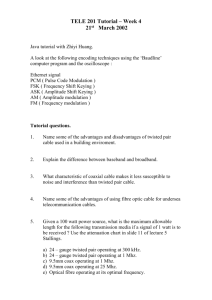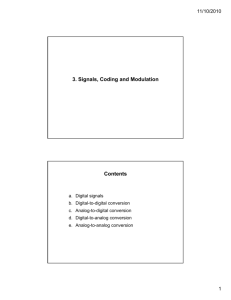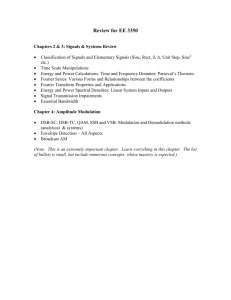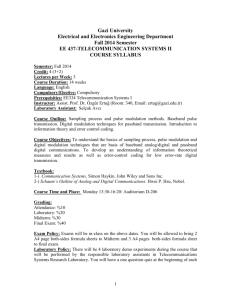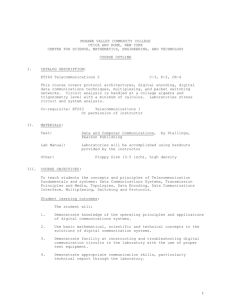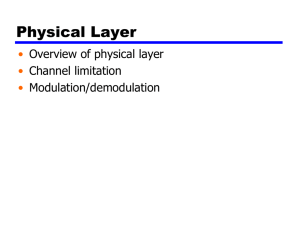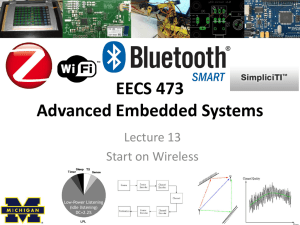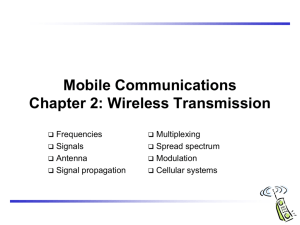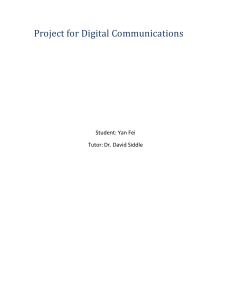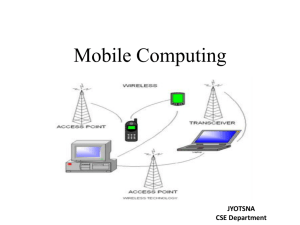MULTIPLEXING
advertisement
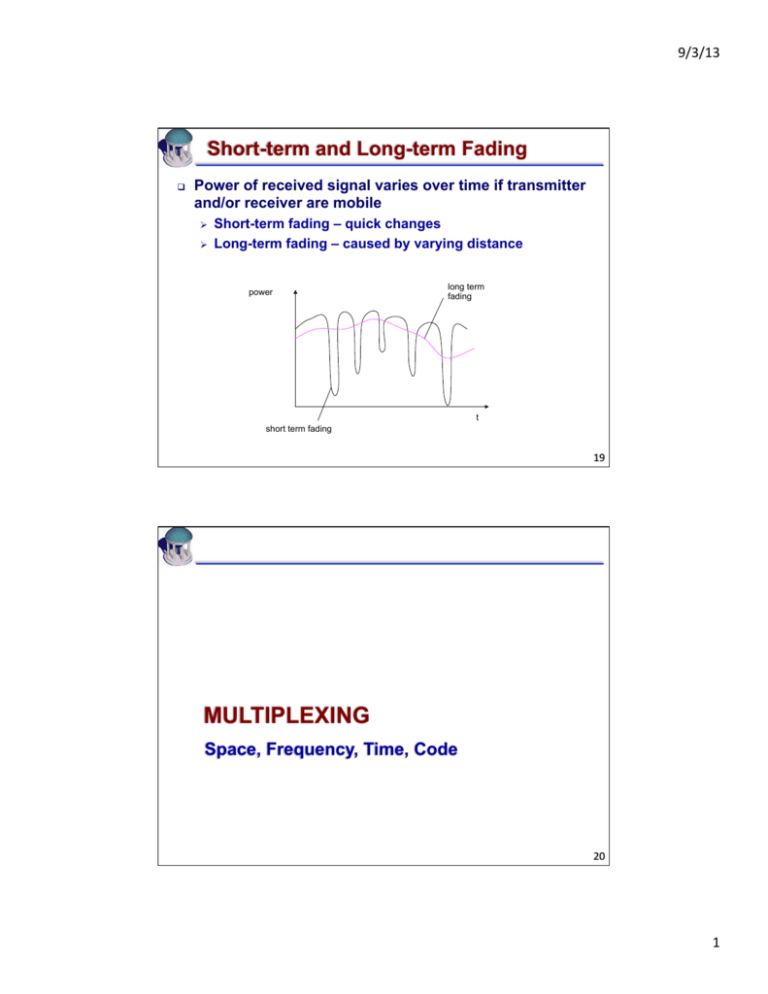
9/3/13 Short-term and Long-term Fading q Power of received signal varies over time if transmitter and/or receiver are mobile Ø Ø Short-term fading – quick changes Long-term fading – caused by varying distance power long term fading t short term fading 19 MULTIPLEXING Space, Frequency, Time, Code 20 1 9/3/13 Multiplexing q Multiplexing: Ø q Multiplexing in 4 dimensions: Ø q Goal: multiple use of a shared medium Space (s), Frequency (f), Time (t), Code (c) Task: Ø Ø Assign space, time, frequency, code to each communication channel Minimize interference § Using “guard spaces” Ø Maximize medium utilization 21 Space Division Multiplex q A separate sender for each communication channel Ø channels ki k1 With wide enough distance between senders Used by FM radio stations Ø q k3 k5 t k6 c t s1 f Many stations around the world use same frequency without interference What if several radio stations want to broadcast in same city? k4 c § Guard spaces q k2 s2 f c t s3 f 22 2 9/3/13 Frequency Division Multiplex q Subdivide the frequency dimension into several nonoverlapping frequency bands Ø Senders can use their assigned band continuously q Used for radio stations within same region q Pros: Ø q No dynamic coordination Cons: Ø Ø Ø k1 k2 k3 k4 k5 k6 c Waste of bandwidth if usage is non-uniform Limits # of senders Inflexible assignment f t 23 Time Division Multiplex q q A sender gets the whole bandwidth for a certain amount of time Advantages Ø Ø q Only one carrier in the medium at any time Throughput high even for many users Disadvantages Ø Precise synchronization necessary k1 k2 k3 k4 k5 k6 c f t 24 3 9/3/13 Frequency and Time Multiplex q Combination: Ø Ø q Pros: Ø Ø q A sender can use a frequency band for a certain amount of time Used by GSM (weak) protection against tapping protection against frequencyk1 selective interference k3 k4 k5 k6 c Cons: Ø k2 f Precise coordination required t 25 Code Division Multiplex q Each channel has a unique code Ø Ø q k2 k3 All channels use same spectrum at same time “guard spaces” realized by using orthogonal code k4 k5 k6 c Pros: Ø Ø q k1 Good protection against interference and tapping Bandwidth efficient f Cons: Ø Ø Ø Relatively complex receiver Precise synchronization required Precise power control required t § All signals should reach receiver with nearly equal strength 26 4 9/3/13 DIGITAL MODULATION Amplitude, Frequency, Phase 27 Modulation digital data 101101001 digital modulation analog baseband signal analog modulation Radio Transmitter radio carrier Radio Receiver analog demodulation analog baseband signal synchronization decision digital data 101101001 radio carrier q Digital modulation: Ø q Digital data is translated into an analog (baseband) signal Analog modulation: Ø Ø Shifts center frequency up to that of radio carrier Small antennas, FDM, frequency-dependent medium characteristics 28 5 9/3/13 Digital Modulation q Modulation of digital signals known as Shift Keying q Issues: Ø Spectral efficiency: § How efficiently is the frequency spectrum utilized Ø Power efficiency: § How much power is needed to transfer bits § Very important for portable devices Ø Robustness to multi-path propagation, noise, interference 29 Digital Modulation Methods q Amplitude Shift Keying Ø Ø Ø Binary values are represented by different amplitudes Low bandwidth requirements Very susceptible to interference § Used only in directed infra-red beams q 0 1 t 1 0 1 Frequency Shift Keying Ø Ø q 1 Needs larger bandwidth Less susceptible to errors Phase Shift Keying Ø Uses shifts in the signal phase t 1 0 1 § 180o, if change in data Ø Ø Ø Synchronization required (freq, phase) Most resistant to interference Complex receiver/transmitter t 30 6 9/3/13 Advanced Frequency Shift Keying Minimum Shift Keying (MSK): avoids abrupt phase changes Ø Bits durations doubled and divided into even, odd bits q § Depending on the bit values (even, odd) the higher or lower frequency, original or inverted is chosen Ø Higher frequency is twice the lower frequency 1 0 1 1 0 1 0 bit even odd 0101 0011 odd bits signal value hnnh - - ++ low frequency h: high frequency n: low frequency +: original signal -: inverted signal data even bits high frequency MSK signal t 31 Advanced Phase Shift Keying q Ø q Q Binary PSK: phase shift of 180o Very simple, but low efficiency 1 Quadrature PSK: phase shift of 45o Ø 0 I Q 10 11 Codes two bits into one phase shift § Relative to phase of a reference signal I – Requires frequent synchronization § Relative to phase of previous two bits 00 01 – More efficient and less complex Ø q Achieves high bit-rates for same bandwidth Can be extended to: Ø Ø Ø More angles Combine with ASK Leads to more receiver complexity A t 11 10 00 01 32 7 9/3/13 Multi-carrier modulation q Splits high bit-rate stream into many with lower bit-rates Ø q Each is sent using an independent carrier frequency Pros: Ø Ø Ø Independent frequencies do not interfere with each other Frequency-selective fading doesn’t influence whole signal Guard spaces used between symbol (groups) § Helps handle multi-path propagation, ISI mitigation Ø q Computationally efficient based on FFT DAB uses 192-1536 sub-carriers 33 8

